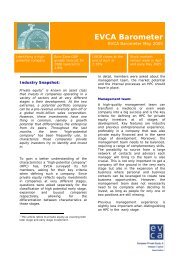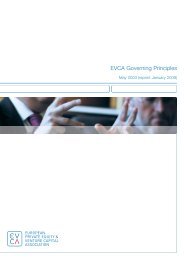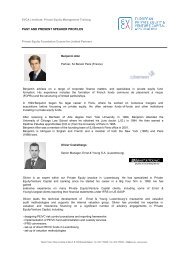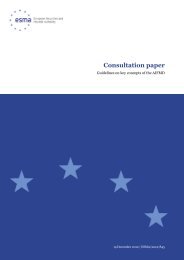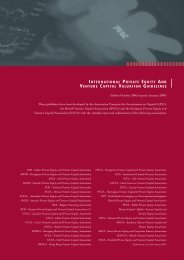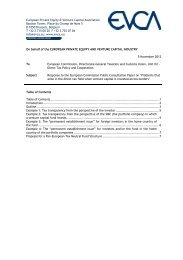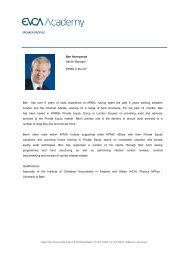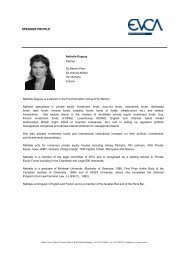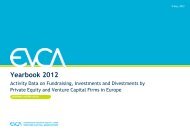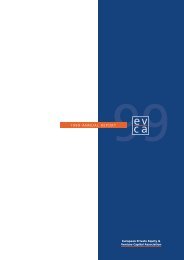Risk Measurement Guidelines - EVCA
Risk Measurement Guidelines - EVCA
Risk Measurement Guidelines - EVCA
You also want an ePaper? Increase the reach of your titles
YUMPU automatically turns print PDFs into web optimized ePapers that Google loves.
Investors need to consider the following factors whenselecting an appropriate methodology for specific portfolios:> The applicability of the methodology, given the natureof the industry and current market conditions> The ability to reflect all relevant risks to which the fundmay be exposed> The quality and reliability of the data used in eachmethodology> The comparability of funds or transaction data> The stage in the lifecycle of the fundThe most widely used methodologies to measure the risk ofprivate equity investments are based on the assessment ofthe volatility of net asset values (NAVs) and that of cash flows.Modelling inputs should include the fund’s NAV, its undrawncommitments, the remaining life of the partnerships,the maturity of the portfolio, future management fees andsuitable discount rates for discounting cash flows. The lengthof time over which the risk is measured and the level of riskshould reflect the investment horizon and other contingenciesthat are idiosyncratic to a particular investor. For example,this could be measured by calibrating the risk with observedlosses for interests in similar funds over a period of one yearor longer and for a given confidence level. Regulated investorsallocate capital based on the risk calculated in this way.4.1 NAV-time series-based modelling approachNet asset value (NAV)-time series-based methodologies assume that the risks of investments in private equity are mainlyrepresented by the volatility of the fund’s net asset value series. Such methodologies are likely to be appropriate for fundswhose value derives mainly from the value of their existing underlying portfolio companies and for investors with a limitedallocation to private equity.NAV-time series-based modelling approaches aim to replicate the methodology used for publicly tradable assets and measurethe volatility of the fund’s NAV-time series. In principle, this is done by looking at – typically quarterly – value changes of theportfolio. Essentially, the idea is to replicate the daily price movements in public markets and then for the purpose of determining,say, a yearly VaR do a “forward annualisation” (see Figure 1).Figure 1: Forward annualisation (VaR based on NAV volatility)Outcome of specificscenarioProjected rangeof scenariostimet0t1<strong>EVCA</strong> <strong>Risk</strong> <strong>Measurement</strong> <strong>Guidelines</strong> 2013 I 15



